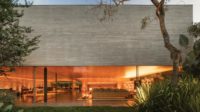São Paulo
It is no surprise to learn that, before turning his hand to architecture, Marcio Kogan directed films. A cinematic quality pervades Casa P, which he designed for a family in the hilly suburb of Morumbi, overlooking the architect’s native city of São Paulo. Here on a sinuous residential road, Kogan’s constructivist fantasy stands out among the large houses of random styles sheltered behind high walls. Consisting of three concrete volumes stacked on top of each other, Casa P gains visual drama from the rotation of the middle one at 90 degrees to those above and below it. With this strategy, Kogan has initiated a dynamic dialogue between the trio of spatial entities, creating an interconnected set of stages and moods, from a covered terrace on the ground to an enclosed aerie at the top.
The volumes of the 8,320-square-foot house decrease in size in ascending order, with a stair (plus elevator) providing the axis around which they rotate. The more formal living rooms dominate the ground floor, separated from the service areas by a stair hall. Along with the master bedroom, the middle level contains three bedrooms en suite, and perched on top in the smallest, highest floor is a spacious family den.
Looking out from the master bedroom on the middle level, the viewer’s gaze is drawn by the long rectilinear terrace on the roof of the lowest volume and outward under the soffit of the overhanging top floor to the skyscrapers on the horizon of South America’s largest city. “This widescreen vision of architecture and the world,” says Kogan, “is one of the things I brought from film to architecture.”
In creating the cantilevered volumes of the house, Kogan relied on exposed poured-in-place concrete rather than masonry walls painted white, which he’d tried earlier in his career. He considers the rough surfaces to be better suited to the poor air quality of this traffic-choked city.
“Exposed concrete is almost eternal,” he notes. It is also a material closely identified with the São Paulo Brutalist school of the post–World War II period, which counts among its luminaries the late female architect Lina Bo Bardi and Pritzger laureate (2006) Paulo Mendes da Rocha.
This connection is important for Studio MK27, which sees itself as part of the tradition of Brazil’s modernist architecture and strives in its work to give a contemporary reading to the city’s design heritage.
Because of the load-bearing walls, the interiors are free of columns, which provides a powerful sense of spatial clarity throughout the house—especially apparent in the expansive living room on the ground floor. Here, floor-to-ceiling glass panels in the elongated walls slide out of sight. The covered terrace opening to the garden illustrates the studio’s goal of a “perfect dialogue between indoors and outdoors.”
This dialogue is continued in the extensive use of a Kogan signature item—the mashrabiya, the Arab wood screen brought to Brazil by the Portuguese. In Casa P, the mashrabiyas extend continuously along the length of the lower two volumes, providing privacy and ventilation in a metropolis located on the Tropic of Capricorn.
The wood weave of the screens also tempers the roughness of the exposed concrete, as does the extensive use of the Brazilian hardwood, ipé, for the floors. Ipé is also used for two enclosures, nested within the ground level and the third floor respectively: one, a three-sided, intimate dining space within the strong horizontal planes of the larger living area; the other, a child’s play area within the family room.
The clients hired Kogan for his “extremely rationalist” solutions, as he puts it. Both members of the couple are business executives—with a small child—who brought their own passion for architecture to the project, says the architect.
For the design team, the greatest challenge was how to maintain the house’s sense of discretion and minimalism while meeting the clients’ exacting demands for modern comforts. This involved hiding an extensive state-of-the-art heating and air-conditioning system within the building’s structure.
The house also displays phenomenal and often playful attention to the practicalities of living. Studio MK27 claims to have devised 2,000 custom designs, many of which appear in the house, such as pop-up electrical outlets and chutes taking dirty linen from the second-floor bedrooms to the basement service area. “Attention to technical detail is in our DNA,” says Kogan. “Clients bring us their desires and dreams, and we try to materialize them,” he adds.
The final result demonstrates the firm’s ability to meet these needs with a sense of cool drama. Sweeping interior spaces reveal views of other rooms along with lush, serene outdoor areas, not to mention panoramic vistas of the city. With every room manifesting a wow factor, Kogan has designed a house to make anyone feel like a movie star.
Irish Times,
Size: 8,320 square feet
Cost: withheld
Completion date: July 2012
Architect:
Studio MK27
Address: Alameda Tiet', 505
S'o Paulo/SP
Brazil
Postal code: 01417-020
Phone: + 55 11 30813522
Website: www.studiomk27.com
People
Architect:
Personnel in architect's firm who should receive special credit:
Collaborators:
Team:
Associate architect(s):
Interior designer:
Engineer(s):
Consultant(s):
Lighting:
General contractor:
Photographer(s):
CAD system, project management, or other software used: |
Products
Structural system:
Exterior cladding
Wood:
Windows
Metal frame:
Doors
Interior finishes
Furnishings
Lighting
Downlights:
Task lighting:
Exterior:
Dimming System or other lighting controls: |













Post a comment to this article
Report Abusive Comment